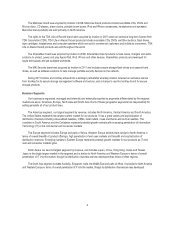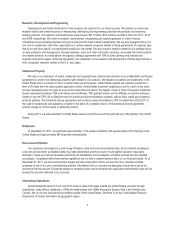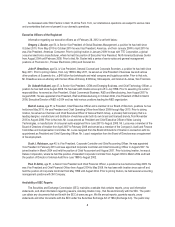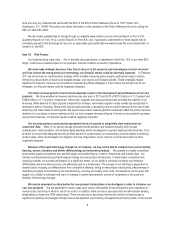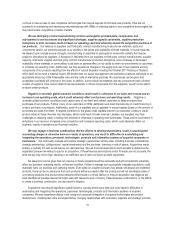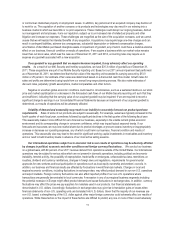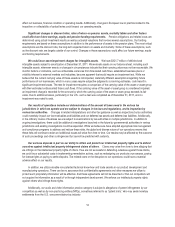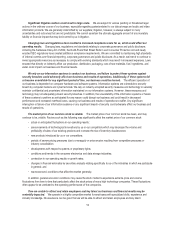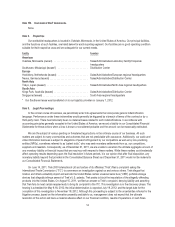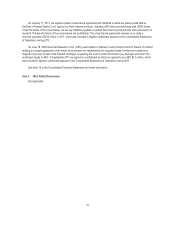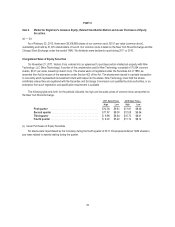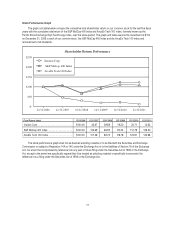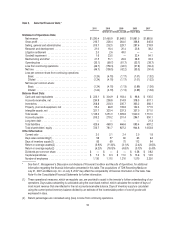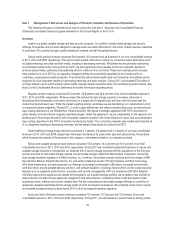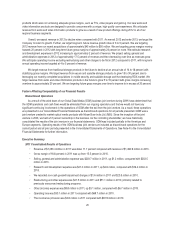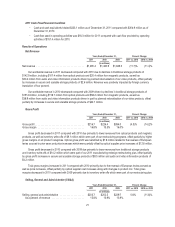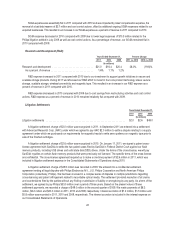Memorex 2011 Annual Report Download - page 15
Download and view the complete annual report
Please find page 15 of the 2011 Memorex annual report below. You can navigate through the pages in the report by either clicking on the pages listed below, or by using the keyword search tool below to find specific information within the annual report.affect our business, financial condition or operating results. Additionally, changes in European law or practice related to the
imposition or collectability of optical levies could impact our operating results.
Significant changes in discount rates, rates of return on pension assets, mortality tables and other factors
could affect our future earnings, equity and pension funding requirements. Pension obligations and related costs are
determined using actual investment results as well as actuarial valuations that involve several assumptions. Our funding
requirements are based on these assumptions in addition to the performance of assets in the pension plans. The most critical
assumptions are the discount rate, the long-term expected return on assets and mortality. Some of these assumptions, such
as the discount rate, are largely outside of our control. Changes in these assumptions could affect our future earnings, equity
and funding requirements.
We could incur asset impairment charges for intangible assets. We have $321.7 million of definite-lived
intangible assets subject to amortization at December 31, 2011. We evaluate assets on our balance sheet, including such
intangible assets, whenever events or changes in circumstances indicate that their carrying value may not be recoverable. We
monitor factors or indicators, such as unfavorable variances from forecasted cash flows, established business plans or
volatility inherent to external markets and industries, become apparent that would require an impairment test. While we
believe that the current carrying value of these assets is not impaired, materially different assumptions regarding future
performance of our businesses, which in many cases require subjective judgments concerning estimates, could result in
significant impairment losses. The test for impairment requires a comparison of the carrying value of the asset or asset group
with their estimated undiscounted future cash flows. If the carrying value of the asset or asset group is considered impaired,
an impairment charge is recorded for the amount by which the carrying value of the asset or asset group exceeds its fair
value. Due to additional losses, particularly in the U.S., such a test was completed as of December 31, 2011, and no
impairment was noted to exist.
Our results of operations include our determinations of the amount of taxes owed in the various tax
jurisdictions in which we operate and are subject to changes in tax laws and regulations, and to inspection by
various tax authorities. Changes in related interpretations and other tax guidance as well as inspections by tax authorities
could materially impact our tax receivables and liabilities and our deferred tax assets and deferred tax liabilities. Additionally,
in the ordinary course of business we are subject to examinations by tax authorities in multiple jurisdictions. In addition to
ongoing investigations, there could be additional investigations launched in the future by governmental authorities in various
jurisdictions and existing investigations could be expanded. While we believe we have adopted appropriate risk management
and compliance programs to address and reduce these risks, the global and diverse nature of our operations means that
these risks will continue to exist and additional issues will arise from time to time. Our results may be affected by the outcome
of such proceedings and other contingencies that cannot be predicted with certainty.
Our success depends in part on our ability to obtain and protect our intellectual property rights and to defend
ourselves against intellectual property infringement claims of others. Claims may arise from time to time alleging that
we infringe on the intellectual property rights of others. If we are not successful in defending ourselves against those claims,
we could incur substantial costs in implementing remediation actions, such as redesigning our products or processes, paying
for license rights or paying to settle disputes. The related costs or the disruption to our operations could have a material
adverse effect on our results.
In addition, we utilize valuable non-patented technical know-how and trade secrets in our product development and
manufacturing operations. There can be no assurance that confidentiality agreements and other measures we utilize to
protect such proprietary information will be effective, that these agreements will not be breached or that our competitors will
not acquire the information as a result of or through independent development. We enforce our intellectual property rights
against others who infringe those rights.
Additionally, our audio and video information product category is subject to allegations of patent infringement by our
competitors as well as by non-practicing entities (NPEs), sometimes referred to as “patent trolls,” who may seek monetary
settlements from the U.S. consumer electronics industry.
12




